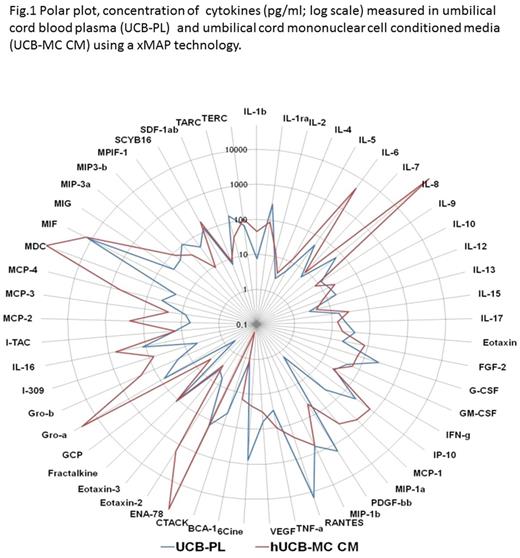Abstract
Introduction. Umbilical cord plasma (UCB-PL) was shown to be beneficial for treatment of ischemic brain injury, Gerotarget/Aging and Alzheimer's disease (Yoo et al., 2016; Castellano et al., 2017). Also, umbilical cord mononuclear cell (UCB-MC) demonstrated therapeutic effect in animal models of stroke, encephalopathy, amyotrophic lateral sclerosis and cerebral palsy (Islamov et al., 2015; Mukhamedyarov et al., 2013). Therapeutic effect of freshly isolated cells is believed t be due to transcriptional activation of numerous neurotrophic, antiapoptotic, proangiogenic pro- and anti-inflammatory factors. The main purpose of this investigation was to analyze the cytokine profile of hUCB-PL and hUCB-MC.
Materials and Methods. Umbilical cord blood was collected into CPDA-1 blood bag and used for plasma (hUCB-PL) separation. Total proteins were normalized in hUCB-PL samples. UCB-MCs were isolated by density gradient sedimentation using Ficoll (1.077g/ml). Separated mononuclear cells were washed and cultured in RPMI-1640 medium (10% FBS, L-glutamine and penicillin-streptomycin antibiotic) at 37°C and 5% CO2. After incubation (72 h) hUCB-MCs conditioned media (CM) was harvested, centrifuged and stored at −80°C. hUCB-PL and hUCB-MC CM were used to analyze cytokines using Bio-Plex Pro™ Human Cytokine 27-plex and Human Chemokine 40-Plex panels. Data collected was analyzed using Luminex 100 or 200 analyzer with Bio-Plex Manager 5.0 software (Bio-Rad).
Results. Many cytokines were detected in hUCB-PL: IL-1β, IL-6, IL-1ra, IL-4, IL-10, IL-13, IL-2, IL-7, IL-12, IL-17, IFN-g, TNF-a, IL-5, IL-9, IL-15, G-CSF, GM-CSF, PDGF-bb, FGF-2, VEGF, IL-8, Eotaxin, MCP-1, IP-10, MCP-1, MIP-1a, MIP-1b, RANTES, 6Cine, BCA-1, CTACK, ENA-78, Eotaxin2, Eotaxin-3, Fractalkine, GCP, Gro-a, Gro-b, I-309, I-TAC, MCP-2, MCP-3, MCP-4, MDC, MIF, MIG, MIP-3a, MIP3-b, MPIF-1, SCYB16, SDF-1ab, TARC, TERC. It should be mentioned that cytokine concentrations varied between individuals. When cytokines were analyzed in hUCB-MC CM samples, increased level of CTACK as compared to that in hUCB-PL. Also, cytokines IL-4, IL-5, IL-7, IL-9, IL-13, IL-15 were absent in hUCB-MC CM samples(Fig.1).
Conclusions. Our data demonstrated numerous cytokines in hUCB-PL and hUCB-MC. Also, we observed individual variability in the level of those cytokines. Therefore, we suggest that the therapeutic effects of hUCB-PL transfusion and hUCB-MC transplantation could be associated with cytokine actions as well as factors which were not included in this analysis. We plan to conduct proteomic analysis of UCB-PL and hUCB-MC to identify molecules producing therapeutic effect. We also suggest that target secretome modulation could be achieved by modification of cells using different genetic constructs containing genes of growth factors and therapeutic molecules. Describes approach is expected to increase therapeutic potential of transplanted cells and annihilate disadvantages of human umbilical cord blood application.
This work was supported by RFBR grant № 16-04-01567
No relevant conflicts of interest to declare.
Author notes
Asterisk with author names denotes non-ASH members.


This feature is available to Subscribers Only
Sign In or Create an Account Close Modal